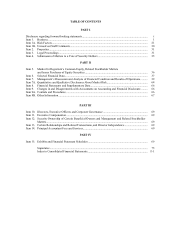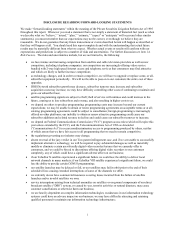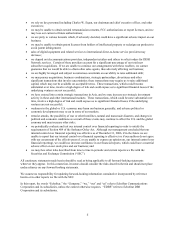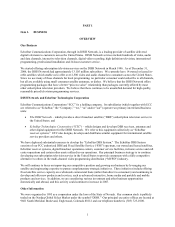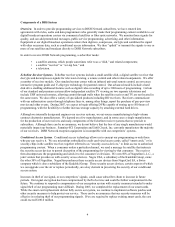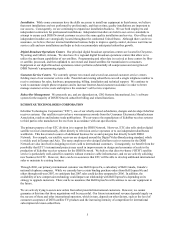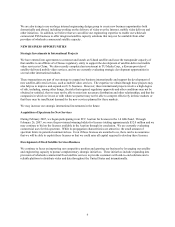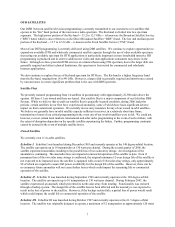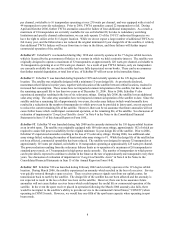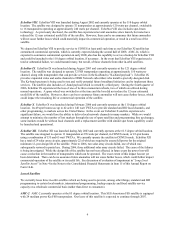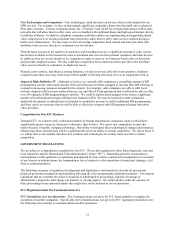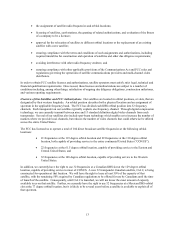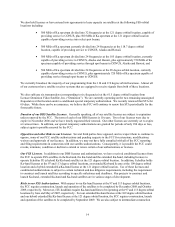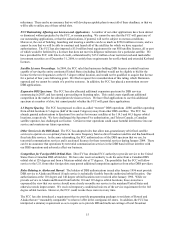Dish Network 2005 Annual Report Download - page 17
Download and view the complete annual report
Please find page 17 of the 2005 Dish Network annual report below. You can navigate through the pages in the report by either clicking on the pages listed below, or by using the keyword search tool below to find specific information within the annual report.7
OUR SATELLITES
Our DISH Network satellite television programming is currently transmitted to our customers over satellites that
operate in the “Ku” band portion of the microwave radio spectrum. The Ku-band is divided into two spectrum
segments. The high power portion of the Ku-band -- 12.2 to 12.7 GHz -- is known as the Broadcast Satellite Service
(“BSS”) band, which is also referred to as the Direct Broadcast Satellite (“DBS”) band. The low and medium power
portion of the Ku-band -- 11.7 to 12.2 GHz -- is known as the Fixed Satellite Service (“FSS”) band.
Most of our DTH programming is currently delivered using DBS satellites. We continue to explore opportunities to
expand our available DTH and wholesale commercial satellite capacity through the use of other available spectrum.
Increasing our available spectrum for DTH applications is particularly important as more bandwidth intensive HD
programming is produced and in order to address new video and data applications consumers may desire in the
future. Although we have provided DTH services on a limited basis using FSS spectrum, due to the larger dish size
generally required and other technical limitations, this spectrum is best suited for commercial and wholesale
business applications.
We also continue to explore the use of Ka-band spectrum for DTH use. The Ka-band is a higher frequency band
than the Ku-band, ranging from 18 to 40 GHz. However, a larger dish is generally required and interference caused
by rain and snow is a more significant problem than is the case with DBS spectrum.
Satellite Fleet
We presently transmit programming from 14 satellites in geostationary orbit approximately 22,300 miles above the
equator. Of these 11 are owned and three are leased. Our satellite fleet is a major component of our EchoStar DBS
System. While we believe that overall our satellite fleet is generally in good condition, during 2006 and prior
periods, certain satellites in our fleet have experienced anomalies, some of which have had a significant adverse
impact on their commercial operation. We currently do not carry insurance for any of our owned in-orbit satellites.
We believe we generally have in-orbit satellite capacity sufficient to recover, in a relatively short time frame,
transmission of most of our critical programming in the event one of our in-orbit satellites were to fail. We could not,
however, recover certain local markets, international and other niche programming in the event of such a failure, with
the extent of disruption dependent on the specific satellite experiencing the failure. Further, programming continuity
cannot be assured in the event of multiple satellite losses.
Owned Satellites
We currently own 11 in-orbit satellites.
EchoStar I. EchoStar I was launched during December 1995 and currently operates at the 148 degree orbital location.
The satellite can operate up to 16 transponders at 130 watts per channel. During the second quarter of 2006, the
satellite experienced anomalies resulting in the possible loss of two solar array strings. An investigation of the
anomalies is continuing. The anomalies have not impacted commercial operation of the satellite to date. Even if
permanent loss of the two solar array strings is confirmed, the original minimum 12-year design life of the satellite is
not expected to be impacted since the satellite is equipped with a total of 104 solar array strings, only approximately
98 of which are required to assure full power availability for the design life of the satellite. However, there can be
no assurance future anomalies will not cause further losses which could impact the remaining life or commercial
operation of the satellite.
EchoStar II. EchoStar II was launched during September 1996 and currently operates at the 148 degree orbital
location. The satellite can operate up to 16 transponders at 130 watts per channel. During February 2007, the
satellite experienced an anomaly which prevented its north solar array from rotating. Functionality was restored
through a backup system. The design life of the satellite has not been affected and the anomaly is not expected to
result in the loss of power to the satellite. However, if the backup system fails, a partial loss of power would result
which could impact the useful life or commercial operation of the satellite.
EchoStar III. EchoStar III was launched during October 1997 and currently operates at the 61.5 degree orbital
location. The satellite was originally designed to operate a maximum of 32 transponders at approximately 120 watts


